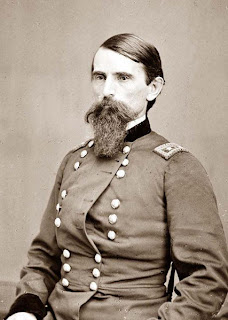Ben-Hur,
A Tale of the Chirst was a novel written in 1880 by Lew
Wallace, a Civil War general (on the Union side), later territorial governor of
New Mexico and author. Although Wallace
wrote many novels and biographies, Ben-Hur
is his ultimate claim to fame.
Almost immediately, Ben-Hur
was adapted for the stage. Wallace did
his best to prevent a stage adaptation (he thought it blasphemous to have
Christ portrayed by an actor.) In 1899, a very famous production opened in
New York (the producers had overcome Wallace’s objections by using a beam of
light to represent Christ), whose major drawing card was a recreation of the chariot
race (with real horses, no less). A
historian described the set-up, "four
great cradles, 20 ft in length and 14 ft wide, which are movable back
and front on railways. The horses galloped full-pelt towards the audience,
secured by invisible steel cable traces and running on treadmills. Electric
rubber rollers spun the chariot wheels. A vast cyclorama backdrop revolved in the opposite direction to
create an illusion of massive speed, and fans created clouds of dust.”
It was a smash hit
with audiences and critics alike. "A
marvel of stage-illusion" that was "memorable beyond all else.” “Thrilling
and realistic ... enough to make the fortune of any play." "The stage, which has to bear 30 tons'
weight of chariots and horses, besides huge crowds, has had to be expressly
strengthened and shored up.” It was
inevitable that the fledging movie industry would look with eagerness on the
best-selling novel and its impressive stage production. In 1907, the Kalem Studios produced a film
version of the story. At over ten
minutes, a good deal of the story had to be sacrificed, but there was still
plenty of spectacle.
The film version centered around the chariot race,
which was filmed on a northern New Jersey beach. The charioteers were all played by local
fireman. The horses were the ones that
usually pulled the fire wagons (this was 1907 after all).
The film starred William S. Hart as Messala, a role he
originated in the Broadway production.
Hart went on to be the first major Western star, appearing in scores of
Westerns in the 1910s and 20s.
This 1907 film is not only famous for being the first
movie adaptation of Ben-Hur, but it
also set a precedent in copyright law in motion pictures. The film was made without the permission of
Wallace’s estate. As the screenwriter,
Gene Gauntier later noted, the early film-makers infringed on anything that
might make a profit. Shortly after the
film’s release, Kalem Studio’s was sued by Wallace’s estate and publisher. In 1911, the U.S. Supreme Court decided in
favor of Wallace’s estate, thereby setting a legal precedent for the use of
copyrighted material in film.
Fortunately, after all these years, the novel and the
film’s copyrights have expired, which means I get to show it to you. So, here it is from 1907, the first film
adaptation of Ben-Hur. Enjoy!
And now another treat!
In 1925, the newly formed MGM Studios invested a lot of money and
prestige in a new film of Ben-Hur. At a cost of 3.9 million dollars, it was the
most expensive movie made to that time (in real dollars, it was more expensive than
the lavish 1959 remake with Charlton Heston.)
It starred Ramon Navarro as Ben-Hur and Francis X. Bushman as
Messala. I’ll write more about this
fascinating production another time.
But I did want to show you the chariot race. The director of the 1925 film, Frank Niblo
shot over 200,000 feet of film for the chariot race alone (it was eventually
edited down to 750 feet, or approximately ten minutes). It is one of the most exciting film sequences
ever captured. If it looks vaguely
familiar, there’s a good reason for that.
One of the assistant directors for the chariot race sequence was a young
William Wyler. He would go on to a great
Hollywood career and was the director of the 1959 Ben-Hur. The spectacular
chariot race in that film is an almost
shot-by-shot recreation of the 1925 chariot race. In 1987, when the film was restored, a new
music score was composed by the British composer, Carl Davis, which makes it
even more exciting. Enjoy!






No comments:
Post a Comment